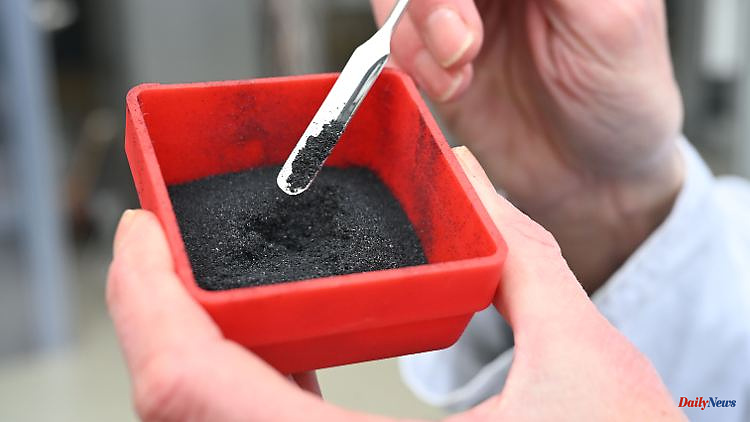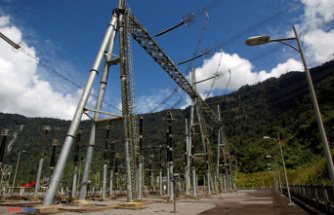In order to become climate neutral, it is not enough to reduce emissions. Experts warn that the removal of greenhouse gases from the atmosphere must also continue. There are different approaches for this. In Karlsruhe, for example, a research team sucks CO2 out of the air and uses it to produce coveted materials.
Even a light breeze is enough to blow away the black powder. It is the high-tech raw material carbon black that researchers at the Karlsruhe Institute of Technology (KIT) literally made from air. They use an apparatus to extract climate-damaging CO2 from the ambient air and use it to produce carbon. Carbon black is not everything, as Benjamin Dietrich from the KIT Institute for Thermal Process Engineering says. Depending on the temperature and pressure, graphite and graphene could also be produced - materials coveted in the industry.
Whether in the construction industry or the paint industry, whether for solar cells, touch screens, lithium-ion batteries or car tires - the possible uses of these products are diverse. For example, the association of the mineral paint industry emphasizes the "excellent" UV protection and the antistatic effect of carbon black, also known as industrial soot. In a study, the market research company Ceresana assumes that global demand for carbon black alone will grow to more than 17 million tons per year by 2030.
On the other hand, half a kilogram of carbon, which according to Dietrich the test facility at KIT produces from two kilograms of CO2 in an eight-hour working day, seems rather puny. But the research team is only at the beginning: With different temperatures between 900 and 1200 degrees and different levels of pressure, they are testing how they can influence the end products.
The whole thing works in a multi-stage process: With the help of a so-called adsorber, CO2 is separated from the air - this is called "Direct Air Capture". In the second step, carbon and oxygen are separated by chemical processes and form new bonds, resulting in methane and water. The methane contains the carbon that is split off in a reactor with liquid tin. This process step is called pyrolysis.
In the project called NECOC, the team investigates how high the energy consumption is and whether pollutants are produced as intermediate products, as Dietrich explains. Parts of the resulting hydrogen, in turn, flow directly back into methanation, for example. In the end, the process "of course only makes sense" if the production of the necessary energy does not produce CO2, Dietrich concedes - that is, if renewable energies are used.
Katja Purr, who heads the "Strategies and Scenarios for Climate Protection and Energy" department at the Federal Environment Agency, sees it that way: If renewable energies were used, the approach promises "a lot of potential for the future". According to Dietrich, it is also conceivable to clean up emissions from the chemical industry, for example, using a scrubbing system that is standard there and to lead the CO2 filtered out in this way directly into the second step of the NECOC process, i.e. methanation. But that's not really the solution for the future, because then work should be done without fossil carbon sources as far as possible - keyword decarbonization. "Chimneys have to become fewer if we want to achieve climate change," emphasizes Purr.
The more urgent main problem is that there is too much climate-damaging CO2 in the atmosphere. Because carbon dioxide is heating the planet. You can only get that through so-called negative emissions - i.e. the removal of greenhouse gases, Purr makes clear. "We need negative emissions, there is no way around it."
However, a report by the Mercator Research Institute on Global Commons and Climate Change (MCC) recently confirmed that the international community has a lot of catching up to do. With new methods, just 0.002 gigatonnes (billion tons) of CO2 would be removed per year. With a view to the climate goals, however, it should be 1,300 times as much by the middle of the century - averaged over various scenarios. To put this in context: According to estimates, global CO2 emissions last year were 40.6 gigatonnes.
There are now several ways in which CO2 is to be stored in huge quantities in the ground, for example, or even converted into stone. "Scientists assume that by separating CO2 from burning fossil fuels and then storing it underground, 65 to 80 percent of the CO2 can be permanently removed from the atmosphere," explains the Federal Environment Agency.
But the technology, known as carbon capture and storage, is controversial. It depends a lot on the subsoil, explains Purr. Close monitoring is necessary to see that the CO2 really stays in the ground. So far, only the research, testing and demonstration of such technologies is permitted in Germany. In this respect, storage in solid carbon, as is the case with NECOC, may also be the safer option, says Purr. "It's the first time I've come across such an approach."
Dietrich from KIT also says that the individual sub-processes have been developed and tested for some time. But: "According to our current state of knowledge, the process network with its special challenges has been implemented for the first time anywhere in the world." In addition, the KIT occupies a leading position worldwide in liquid metal-based pyrolysis as an essential sub-step.
This fits in with current discussions, because it is now becoming more and more important not only to store CO2, but to reuse it. Shortly before Christmas, the federal government decided to develop a carbon management strategy this year. The CDU national board, in turn, spoke out in favor of "real CO2 recycling" at a closed conference in mid-January. Climate neutrality cannot be achieved by avoiding CO2 emissions alone.
However, NECOC is still in its infancy. The test facility, which the KIT set up with two companies, is set up on a container scale. Just basic research. When asked when it could be used on a larger, relevant scale, Dietrich dared not make any predictions: "There are still a few steps to be taken."












